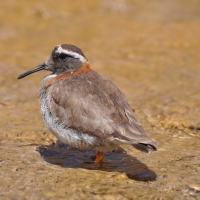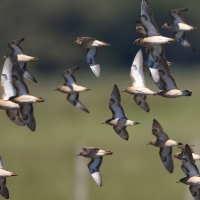Shorebird Status
Shorebirds are among nature’s most ambitious, long-distance migrants.
But their numbers are dropping quickly. Shorebirds are among a few groups of birds showing the most dramatic declines. Species that undertake hemispheric migrations rely on specific habitats and food sources to survive, but these resources are increasingly under threat from human disturbance, habitat loss and degradation, over-harvesting, increasing predation, and climate change.
Shorebird populations began to decline in the 1800s, in part due to market hunting. In the Americas, the Eskimo Curlew (Numenius borealis) was hunted so heavily that it is now presumed to be extinct. As humans have continued to alter the landscape, shorebird populations have further decreased, with declines increasing rapidly in recent decades.
Danger in Numbers
The very reason that protecting a network of sites is a critical component of shorebird conservation also makes shorebirds vulnerable. Many species gather in large numbers to rest and refuel during migration. Loss of any one of these critical staging areas could mean the destruction of a species’ whole flyway population.
Climate Change, Habitat Change
Climate change is happening now. With shorebirds’ reliance on coastal wetlands, the Arctic tundra, saline lakes in arid regions, and highly specified food resources during migration, they are extremely vulnerable to the changes that are occurring, such as:
- Loss of habitat due to rising tides
- Hotter and drier conditions in some regions
- Shrub encroachment on nesting habitat in a warming Arctic
- Mismatched timing of migration and food resources
Of 52 shorebird species that regularly breed in North America, 90% are predicted to experience an increase in risk of extinction. This includes 28 species already considered at high risk of extinction, and 10 imperiled species that face even further increased risk.*
* Source: Predicting Vulnerabilities of North American Shorebirds to Climate Change.
Galbraith H, DesRochers DW, Brown S, Reed JM (2014) Predicting Vulnerabilities of North American Shorebirds to Climate Change. PLOS ONE 9(9): e108899.
International and Regional Assessments

Global Conservation Status (IUCN)
Of the regularly occurring shorebirds in the Americas, the International Union for Conservation of Nature (IUCN) currently considers 13 to be of conservation concern at the global level. The list includes one species considered Critically Endangered (Eskimo Curlew Numenius borealis), one species considered Vulnerable (Bristle-thighed Curlew Numenius tahitiensis), and 11 species considered Near Threatened, including:
- Piping Plover (Charadrius melodus)
- Mountain Plover (Charadrius montanus)
- Snowy Plover (Charadrius nivosus)
- Diademed Sandpiper-Plover (Phegornis mitchellii)
- Bar-tailed Godwit (Limosa lapponica)
- Red Knot (Calidris canutus)
- Semipalmated Sandpiper (Calidris pusilla)
- Buff-breasted Sandpiper (Calidris subruficollis)
- Imperial Snipe (Gallinago imperialis)
- Fuegian Snipe (Gallinago stricklandii)
- Noble Snipe (Gallinago nobilis)
Further information on these species of concern can be found on BirdLife International’s online datazone.

Convention on Migratory Species (CMS)
The Convention on the Conservation of Migratory Species of Wild Animals (CMS) is an environmental treaty under the aegis of the United Nations Environment Program. It provides a global platform for the conservation and sustainable use of migratory animals and their habitats. CMS brings together countries through which migratory animals pass and lays the legal foundation for internationally coordinated conservation measures throughout a migratory range.
Migratory species listed in CMS are divided between two appendices, each specifying distinct obligations. In certain circumstances, a migratory species can be listed in both Appendices at the same time.
Appendix I comprises migratory species that have been assessed as being in danger of extinction throughout all or a significant portion of their range.
Appendix II covers migratory species that have an unfavorable conservation status and that require international agreements for their conservation and management, as well as those that have a conservation status which would significantly benefit from the international cooperation that could be achieved by such an agreement.
Five species that occur in the Americas are currently listed in Appendix I of CMS:
- Eskimo Curlew (Numenius borealis)
- Bristle-thighed Curlew (Numenius tahitiensis)
- Red Knot (Calidris canutus rufa)
- Semipalmated Sandpiper (Calidris pusilla)
- Buff-breasted Sandpiper (Calidris subruficollis)
Appendix II lists all species that fall within the families:
- Haematopodidae
- Recurvirostridae
- Charadriidae
- Scolopacidae
- Pluvianellidae
United States
The U.S. Shorebird Conservation Plan (USSCP), developed in 2004 and updated in 2016, generated conservation concern levels for 57 shorebird species, subspecies, or populations that regularly occur in the United States.
- Five species listed by the Endangered Species Act
- Seven species of “Greatest Concern”; 19 species of “High Concern”
- Thus, more than half (31) of the 57 shorebird species that breed in the U.S. are at grave risk.
- Shows that the status of shorebirds in North America has not improved over the last decade, and that it has even become slightly worse: in the 2004 USSCP, only 29 species were considered at high risk.
Canada
The status of shorebirds in Canada was evaluated in the Canada Shorebird Conservation Plan (CASP), published in 2001. The plan evaluates the status of 47 species of shorebird that breed or occur on a regular basis within Canadian borders.
- Five “Highly Imperiled” species
- 17 species of “High Concern”
- Thus, also more than half (27) of the considered 47 shorebird species that breed or regularly occur in Canada are considered of substantial risk.
Currently, the status of shorebirds is evaluated periodically by the Committee on the Status of Endangered Wildlife in Canada (COSEWIC). At this time, of all Canadian shorebird species, five taxa are considered “Endangered,” one taxon is considered “Threatened,” and four taxa are considered of “Special Concern”. Except for one species, all these taxa are also listed on the Species at Risk Act (SARA) of Canada.
Latin America and the Caribbean
The status of shorebirds in Latin America and the Caribbean has yet to be evaluated as thoroughly as elsewhere in the hemisphere. 15 species of shorebirds are considered of conservation concern on a country level, with species listed on the national RedLists of Argentina (2015), Uruguay (2017), Brazil (2012) and Chile (2017). Of these species, nine are restricted to the region. Species considered of conservation concern by nearly all four of these countries are the Eskimo Curlew and Red Knot (ssp. rufa).
More information on the specific national redlists can be found here:
Page photos top to bottom: Diego Luna Quevedo, Shiloh Schulte, Diego Luna Quevedo, Brad Winn, Brad Winn, Brad Winn, Diego Luna Quevedo.




